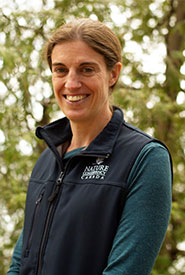Mhairi’s bird of the day: Lesser scaup
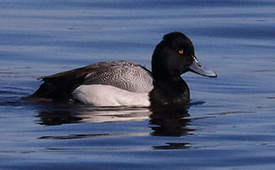
Lesser scaup (Photo by Christian Artuso, CC BY-NC-ND-4.0)
Spotted on March 24, 2020
Lesser scaup
Aythya affinis
Aythya: from aithuia in ancient Greek, meaning “seabird”
Affinis: “related to” in Latin
Some birds are easy to identify at a glance, and some are fairly easy with a bit of a more thorough look and a bit of practice. Others, well — are always hard! My morning pre-work jaunt today included a whole flock of the latter: scaup. While I do like seeing all birds, and the more species the better, I have to admit to my heart sinking just a little bit when I scanned a flock of ducks and noticed some scaup.
Related content:
I’d stopped safely off the road beside some old gravel ponds, beside our local now-closed provincial park. These ponds are well-known locally as being a great spot for waterfowl, especially during late winter as they congregate briefly on their way to their breeding habitats mostly further north.
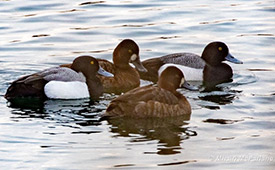
My group of mystery scaup (two males, two females), mostly carefully hiding the shape of their heads from me. (Photo by Mhairi McFarlane/ NCC staff)
My approach is to give the whole pond a quick scan with my binoculars to see if there is anything obviously exciting I should focus in on first, and to get a sense of who is out there. I then set up my telescope and scan through the whole flock more carefully, counting the number of individuals in each species. On a busy day, this can involve making many passes through the flock until everyone is accounted for on my eBird checklist. I scanned through and counted some buffleheads, a few common mergansers and common goldeneye, until I really couldn’t put off sorting out the scaups any longer.
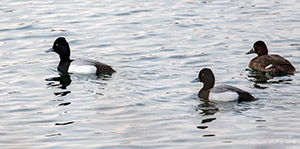
The same group, showing me the little “notch” just behind the crown of their heads. Not “evenly rounded” afterall, so these are lesser scaup. (Photo by Mhairi McFarlane/ NCC staff)
The problem is, there are two species of scaup in Ontario: greater scaup and lesser scaup. These two species are very good at looking almost identical, unless you get the light and angle just right. Sometimes, especially for distant birds, you really can’t tell. I was lucky, as there was a small group quite close to shore, so I was able to take a few photos. In the field, I had more or less decided that this group was greater scaup. Their heads looked evenly “rounded,” which is one of the key features.
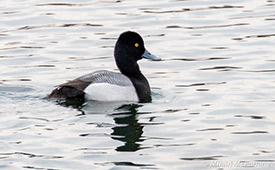
One of the males showing the relatively straight back of his head typical of lesser scaup. (Photo by Mhairi McFarlane/ NCC staff)
However, once I took a look at my photos, and reminded myself of some of the other features to check, I changed my mind to lesser scaup. Let me know if you disagree!
Here’s my eBird checklist

